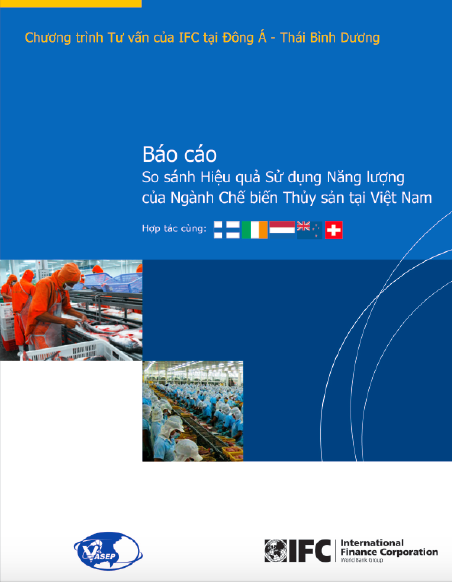In order to support enterprises to reduce production costs by energy efficiency measures, the International Finance Corporation (IFC), the member of World Bank Group, coordinated with Finland, Iceland, Netherlands, New Zealand, and Switzerland, have combined with Vietnam Association of Seafood Exporters and Producers (VASEP) to conduct a study comparing the energy efficiency of the aquatic processing sector. This study was implemented by Energy Conservation Research and Development Center (ENERTEAM), Viet Nam, in collaboration with Tien Giang Energy Efficiency Center (ECC-Tien Giang). The study was enthusiastically supported by many seafood enterprises.

This report aims to provide information to enterprises about the reference energy consumption levels so that the factories can self-evaluate the energy efficiency, thereby identifying energy saving measures to reduce production cost and enhance product competition.
There are 21 selected factories for consulting and analyzing, including 11 shrimp processing factories (accounting for 5.7% of the aquatic processing sub-sector) and 10 shutchi catfish processing factories (equivalent to 5.2% of the aquatic processing sub-sector) of total 193 shrimp and fish processing factories in the Mekong Delta at present. In the survey period (2009), these factories processed more than 41,000 tons of processed shrimp and nearly 155,000 tons of processed fish. Total energy consumption per year is more than 17.8 thousand TOE. Energy costs are nearly 212.5 billion VND/year. GHG emission is 133.5 thousand tons of CO2/year.
The main part of this report focuses on comparing the energy efficiency of the shrimp processing and shutchi catfish processing sub-sector. The indicators selected for comparison include: total specific energy consumption (total energy consumption per unit of product); specific energy consumption and energy consumption ratio of each stage (freezing, cold storage, water chilling and air conditioning, ice making); specific energy consumption per labor; total energy costs per unit of product; specific water consumption of the product; specific CO2 emission of the product; average lifetime of production equipment and current status of energy management.
The indicators will be compared according to the following 3 groups of factories: the group of 25% factories with the best index, 50% factories with the average index, and 75% with the lowest index (as known as groups 25%; 50% and 75%).
The report is compiled and published in Vietnamese and English version.
ENERTEAM has implemented this project in 2009, so the consulting, studying, and calculating data of energy efficiency of the Aquatic Processing sector (applicable to shrimp and catfish groups) in Mekong Delta was at this period. Currently, the Ministry of Industry and Trade (MOIT) has issued a new Circular on updating energy consumption quotas of the aquatic processing sector. You can refer to the Circular of the MOIT here Circular of the Aquatic Processing Sector.
We hope this report can be a necessary and useful reference. For further advice or information, do not hesistate to contact ENERTEAM.


Ý kiến của bạn